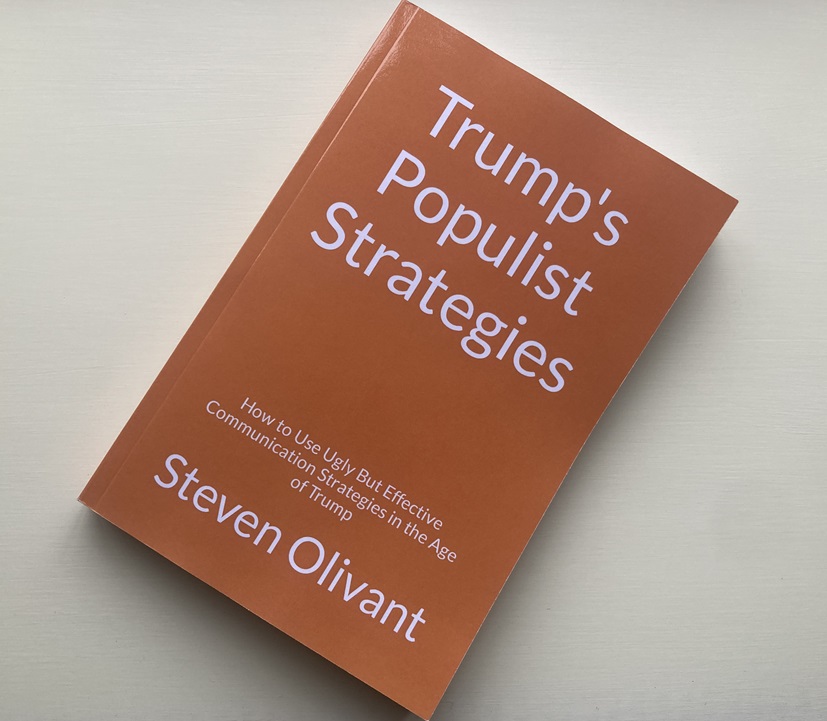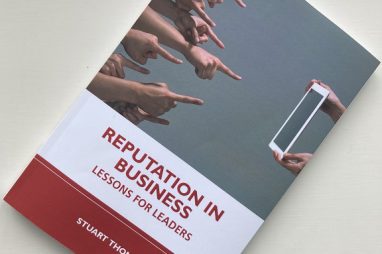Review: Trump’s Populist Strategies

About the author
Richard Bailey Hon FCIPR is editor of PR Academy's PR Place Insights. He teaches and assesses undergraduate, postgraduate and professional students.

Trump’s Populist Strategies: How to Use Ugly But Effective Communication Strategies in the Age of Trump
Steven Olivant
Steven Olivant, 274 pages, 2024
Unconventional wisdom
We are facing a rerun of the 2020 US presidential election, a contest between Donald Trump and Joe Biden.
Trump appears to be the frontrunner – despite the chaos of last time, the lawsuits, the Capitol Hill riots, the lies. So it’s a good time to ask what makes populism – exemplified by Donald Trump – so popular. Our guide is an experienced British corporate communicator who identifies Trump’s winning strategies, often pursued in the face of conventional wisdom.
Steven Olivant has form as an author. His previous self-published book, Keeping Shtum, sought to overturn received crisis management wisdom. Using Apple as his exemplar, he argued that commercial and critical success does not always follow from an ‘open system’ approach to communication and collaboration. Apple is a fiercely closed and secretive corporation that has nonetheless achieved unprecedented commercial success and critical acclaim.
If Apple is the exception that proves the rule, then the rules underpinning Trump’s approach to campaigning and governing are the subject of this new book.
Olivant argues that a Winners Strategy was pursued in 2016 – the focus was on firing up supporters, even at the risk of alienating many other groups. In a closely fought election, it’s not only about who votes for you and who votes against you, but who is motivated to turn out to vote and who decides to stay at home and not cast theirs.
Yet conventional wisdom argues for a Middle Ground Strategy in two-party electoral systems in order to achieve the broadest possible coalition and win the support of swing voters in the middle.
The author is British, with experience of working in the US, and his book follows US spelling conventions.
‘Trump’s Winners Strategy was to sacrifice winning over voters in the center in favor of identifying his natural supporters from the white less-educated rural minority and focusing on persuading them to go out and vote.’
Supporting this strategy is Trump’s cult of personality honed through operating in the business, media and celebrity worlds for decades before seeking election. His approach follows the ‘no such thing as bad publicity’ axiom that’s no longer conventional public relations wisdom.
Back in 2015-16 an insurgent with no previous political experience won the Republican nomination and then the presidential election. Yet it’s one thing to campaign as an insurgent. But how do you translate this into governing?
Olivant’s wry observation is that ‘people could not say they had not been warned.’ By leading with personality, Trump had become Marmite: people either loved him or hated him. ‘The Personality Strategy worked for Trump as an entertainer. It worked for him, spectacularly, as a candidate. But as president, it was ultimately a turn-on for the hard core but a turn-off for many others.’
What about the lies? ‘The Washington Post fact checker team found that the president made 836 “false or misleading claims” in his first six months in office.’ In his final year in office, there were 39 of these per day.
There appears to be a gulf between such reckless political rhetoric and the caution adopted by most corporations and especially listed companies. Yet once again Olivant is a contrarian. He argues that businesses necessarily talk up their prospects to customers and investors – a process charted in the well-known Gartner Hype Cycle. Borrowing from this he describes the approach as the ‘hyperbole strategy’ (reverting to lowercase). Yet he warns: ‘hyperbole is not forever.’ Unicorns are not real!
Populism and speculation make fine bedfellows. The spectacle of the rich getting richer while the rest stood still (at best) fomented resentment.
Now for the link to the political narrative. In the context of the global financial crisis, Olivant notes that ‘populism and speculation make fine bedfellows. In the West, the spectacle of the rich getting richer while the rest stood still (at best) fomented resentment… The hyperbole strategy is a perfect fit for populist politicians: promise the earth – it is going to be so easy – only the corrupt elite stands in the way.’
The central chapter in the book is called (Non)-Disclosure. It addresses questions of truth and transparency. Textbooks are clear on our obligation to tell the truth; the author provides some nuance to this discussion.
‘Politicians sometimes get away with blatant lies, at least to their supporters; quoted companies cannot. They are obliged to tell the truth, but even quoted companies are not obliged to tell the whole truth.’
He observes: ‘The case for disclosure is partly legal – that material information must be disclosed. It is partly ethical – that the truth should be told. And it is partly practical – that the truth may (or may not!) come out anyway.’
In the context of disclosing the health conditions of prominent leaders, he notes that ‘the case against disclosure is also partly ethical – the right to privacy.’
In exploring the cult of personality, Olivant traces America’s ‘talent for promotion’ back to Queen Elizabeth I (Gloriana, the Virgin Queen). I’d go further and add the following: that the state of Virginia was named for Queen Elizabeth a few years after her death and several years before the Mayflower set sail. So history suggests the United States owes more to trade and the profit motive than it does to God-fearing Puritans, though that’s never the narrative repeated at Thanksgiving.
He argues that Trump follows in the tradition of PT Barnum (‘The Greatest Showman’).
Somehow, the showmanship works – in the same way that misinformation and disinformation are designed to spread. ‘Every time a Trumpism is repeated, it spreads like a germ. It is possible, but more difficult, to counter the Trumpism without repeating it.’
It’s an interesting read, but I’m left with several questions and observations.
- Why did a British comms expert choose to explore US politics while all the same questions could be asked of the rise and fall of Boris Johnson (or much more fleetingly Liz Truss) much closer to home?
- How would you advise a boss like Donald Trump – while maintaining your integrity and retaining your job? Advisers and media spokespeople have come and gone with great rapidity, and many seem to end up in positions of enmity (Steve Bannon, Anthony Scaramucci).
- There’s an obvious distinction between campaigning and governing: Trump and Johnson were both strong in the former and exposed in the latter role. How does this compare with the leadership role in corporations? Despite the misleading marketing and PR trade press focus on award-winning campaigns, governing is a closer match to running an organisation than campaigning.
- It seems to me that culture wars framing is more important than traditional left-right political framing in predicting how people vote. So I’d have welcomed fuller analysis of the power and impact of culture wars on political identity because of the obvious relevance to corporate positions on diversity, equity and inclusion (DEI) and environmental, social and governance (ESG) issues.
The useful take away from this book is not about Trump at all, but about the contribution of PR and comms to winning.
The conventional academic wisdom is to shun the overt persuasiveness of public relations, and argue for a more consensual (or ‘two way symmetric’) approach. But there are authors who have argued against this position, notably Kevin Moloney and Conor McGrath in the third edition of Rethinking Public Relations where they state ‘public relations is weak propaganda: it is persuasive communication for competitive advantage.’
Olivant’s realistic rather than idealistic view of PR and comms is also echoed by Trevor Morris and Simon Goldsworthy: ‘Public Relations is the planned persuasion of people to behave in ways that further its sponsor’s objectives.’
He may not be the only contrarian in town, but he has an interesting perspective to offer.


